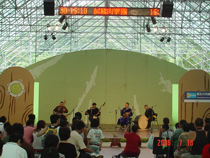 Few people in Taiwan will have heard of the Tuva Republic or be aware that it is home to one the world's most unusual cultural experiences. Tuva is in south-central Siberia and borders northwestern Mongolia. It is an agricultural region with its people being mainly occupied with sheep herding and raising cattle. It has a diverse climate with temperatures ranging from -50 degrees Celsius to 38 above. Over the centuries the Tuvan people have been under the rule of Chinese emperors, Mongol warlords, and Russian czars. The Tuvan people have now achieved a state of autonomy within the Russian federation. The South Pacific Ocean Studio (SPOS) recently won a competition held by the Mongolian and Tibetan Affairs Commission (MTAC). With the funding SPOS were awarded form MTAC and other sponsors they elected to bring a Tuvan dance troupe and Khoomei performers to tour Taiwan. Few people in Taiwan will have heard of the Tuva Republic or be aware that it is home to one the world's most unusual cultural experiences. Tuva is in south-central Siberia and borders northwestern Mongolia. It is an agricultural region with its people being mainly occupied with sheep herding and raising cattle. It has a diverse climate with temperatures ranging from -50 degrees Celsius to 38 above. Over the centuries the Tuvan people have been under the rule of Chinese emperors, Mongol warlords, and Russian czars. The Tuvan people have now achieved a state of autonomy within the Russian federation. The South Pacific Ocean Studio (SPOS) recently won a competition held by the Mongolian and Tibetan Affairs Commission (MTAC). With the funding SPOS were awarded form MTAC and other sponsors they elected to bring a Tuvan dance troupe and Khoomei performers to tour Taiwan.At a press performance, prior to the opening performance at Sun Yat-sen Memorial Hall on Wednesday in Taipei, the Sayany Dance Troupe gave a demonstration of a salutary dance in which the dancers wear traditional costumes and dance with an air of innocence and pride in their national display. According to the program literature the Sayany Troupe aims to promote Tuva's "spiritual and cultural perfection by carrying it to people of different nations." Next came a performance by a solo Khoomei singer. Khoomei, roughly translated means "throat singing". When you hear the variety of low droning hums and high-pitched flute-like sounds, pulsing and resonating, it's hard to believe this is just one man with a single stringed instrument. At first the effect makes you look around for a hidden orchestra. When you realize there isn't one you just sit back and marvel at the uniquely remarkable phenomenon on show. Peter Yu, a visual worker with SPOS said, "I believe once people hear the wonderful sounds that these throat singers are able to produce, they will not be able to forget them." The singer produces these sounds by manipulating the harmonic resonances created as air travels from the lungs, past the vocal folds, and out of the lips. The sounds are selectively amplified by changing the shape of the resonant cavities of the mouth, larynx and pharynx. The throat singer is able to create six different pitches at the same time. The result gives the impression of a number of bowed and plucked instruments being played together. Tuva's throat-singing has been made famous by the master of the art, Ondar Kongar-ool. His picture graces the cover of the Lonely Planet's new book on the Trans-Siberian Railway. He performs in the Taiwan shows and is responsible for having taught all the other performers.
|
